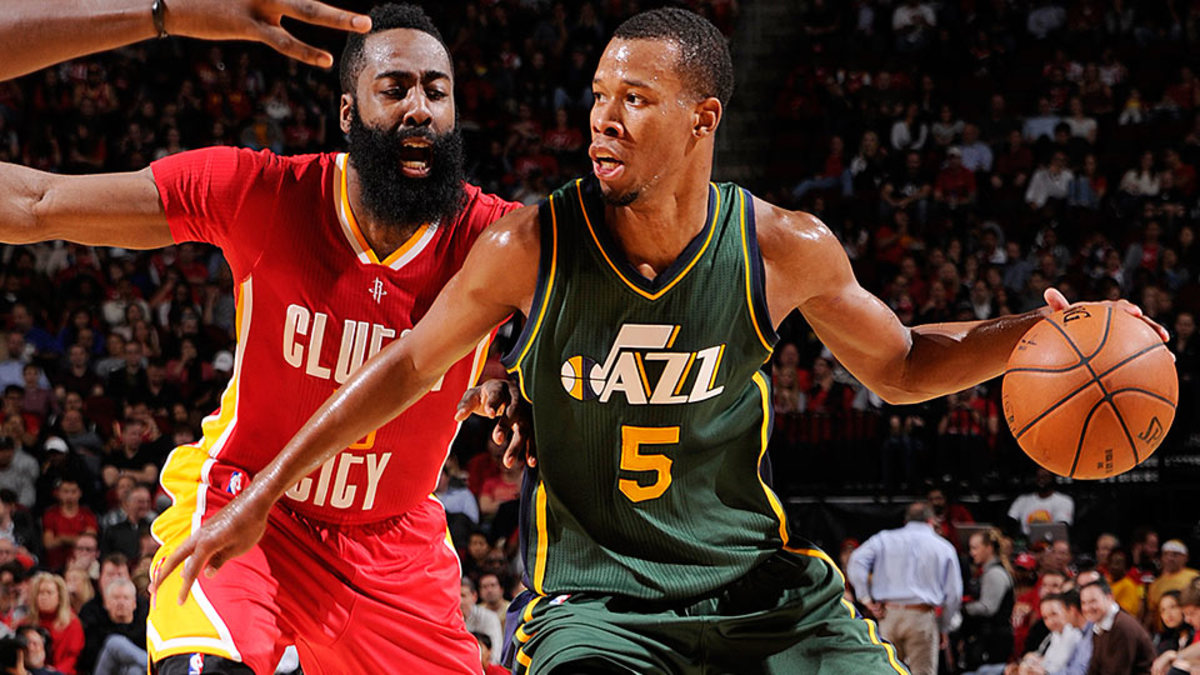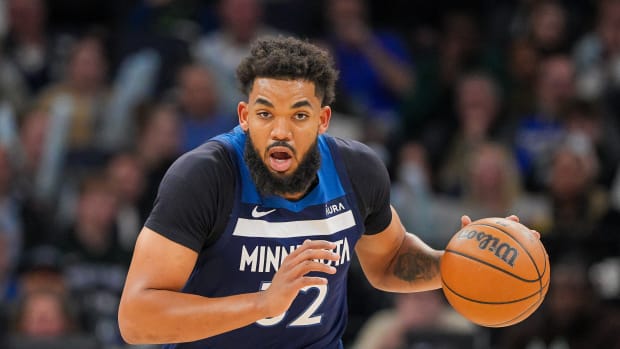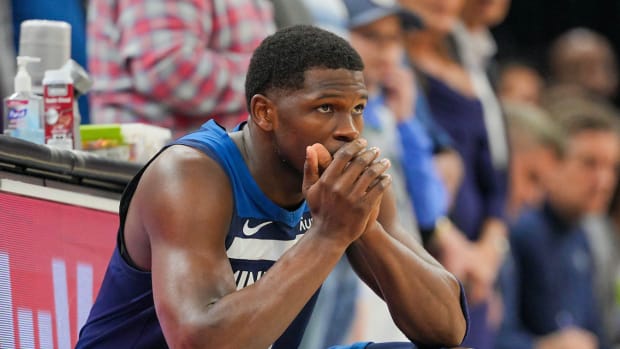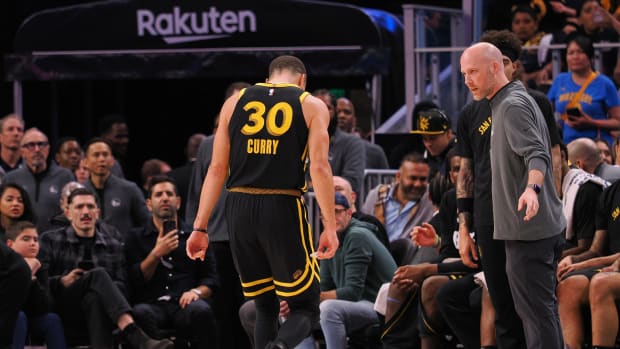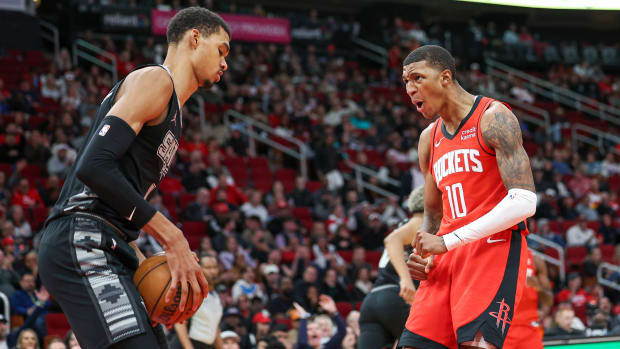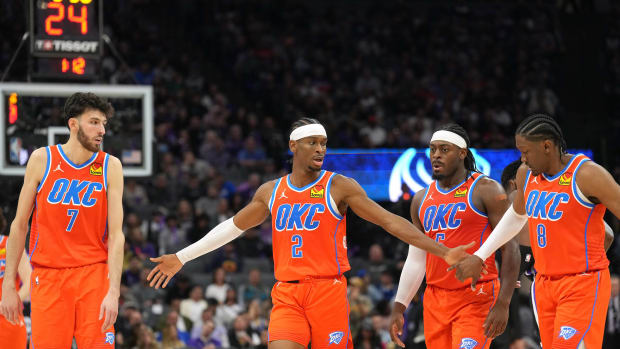Rodney Hood outshining peers as he models game off another crafty lefty
The 2014 NBA draft’s current leader in Win Shares isn’t Andrew Wiggins or any of the 13 lottery picks selected after the reigning Rookie of the Year.
No, one needs to keep scanning down the list, past the unproven likes of Bruno Caboclo and Jordan Adams, to find Rodney Hood, who slid well out of the lottery on draft night and landed at No. 23. Hood wasn’t the first player taken out of Duke (that would be Jabari Parker at No. 2) and he wasn’t even the first player taken by Utah (that was Dante Exum at No. 5).
After sitting out the 2012–13 NCAA season as a transfer and then spending his lone year at Duke playing in Parker’s shadow, Hood was a bit of an afterthought on draft night. Here was a “solid” complementary wing, a spot–up shooter and versatile defender whose feel for the game surpassed his raw athletic potential, landing far off the map in Utah with a rebuilding Jazz team that had just recently hired rookie coach Quin Snyder. Everything about that last sentence screams, “Check back in a year or two.”
Well, it’s been more than a year and a half, and Hood’s recent play demands that check in. The 6'8" guard averaged 18.6 points, 3.8 rebounds and 2.6 assists in January, emerging from a pile of injuries to become a badly-needed source of both scoring and playmaking for a Jazz team that is deliberate (dead last in pace) and prone to choppiness (No. 26 in assist rate). Hood, 23, not only leads his class with 5.4 Win Shares, topping Marcus Smart at 4.6 and Wiggins at 4.1, but he also ranks among the class's leaders in Player Efficiency Rating and ranks in the top 10 among all shooting guards in Real Plus-Minus. Last week, he was selected to compete in the 2016 Rising Stars Challenge; only five of the 22 players selected before him in 2014 will join him at the All-Star Weekend event.
“I was better than [pick] No. 23,” Hood told SI.com by telephone this week. “And I feel like those things will be proven on down the line.”
Suns mercifully axe Jeff Hornacek as franchise continues to spin aimlessly
There’s not a hint of anger in his voice, even though it’s clear he means what he says. Instead, Hood sounds like he’s soaking in good vibes in all directions. He enjoyed a sizzling 62.3 True Shooting Percentage in January, and the Jazz’s two centerpiece bigs, Rudy Gobert and Derrick Favors, had just started alongside each other for the first time since November. After surviving a 7–11 stretch without Gobert, Hood was upbeat that Utah hadn’t fallen out of the West’s playoff conversation and looking forward to injured guard Alec Burks returning to the court “soon after the All-Star break.”
The “proving” that Hood referred to is already well underway. To understand how important his recent emergence has been, one must note the full scope of Utah’s injury woes: Exum has missed the entire season, Gobert has missed 20 games, Burks has missed 18, and Favors has missed 17 games. Entering Monday’s action, Utah hadn’t field a single lineup that had logged at least 175 minutes together and it had fielded just one five-man combination that had appeared in more than 15 games together. Hood’s favorite lineup—the so-called “Triple Wing” that features himself, Burks, Gordon Hayward, Favors and Gobert—has played a whopping 39 minutes together this season. Snyder has been running a MASH unit and he’s been doing it with one of the NBA’s youngest rosters and without a truly reliable point guard option.
Simply put, Snyder has been looking for help wherever he can find it, and Hood has responded by accepting additional ball-handling and offense-initiating duties. After posting a 19.6 usage rate last year, Hood’s usage climbed to 24.7 in January as he helped lift Utah to a top-10 offensive efficiency rating.
• MORE NBA: WOO: Jazz up to No. 17 in latest NBA Power Rankings
This expanded role has allowed Hood to showcase his abilities as both an isolation scorer (Synergy Sports rates Hood in the 96th percentile in isolation situations) and as a pick-and-roll ball-handler (88th percentile). While Hood is lanky and rarely explodes for above-the-rim plays, his offensive game features both pace and purpose: he’s comfortable creating space and scoring opportunities off the dribble in one-on-one situations, he prefers deliberate and careful movements to recklessness, and he has developed an advanced understanding of how to use his body to remain in attack mode even when he enters in traffic.
In that last respect, Hood has tried to model his on-the-ball game after a fellow lefty.
“This past summer I really worked with [Jazz assistant] Johnnie O’Bryant and coach Snyder on my pick-and-roll reads and slowing down once I get the defender on my back,” Hood said. “I want to get to the ‘pick your poison’ type of situations like James Harden. A lot of good pick-and-roll players keep the defenders on their back so they can see the whole floor.
“When I come off [a screen], I try to get the defender on my back by using my size. I’m bigger than most two guards. Shield them off. Then I just try to see the floor. Is there a lob? Can I make an extra pass to a shooter? If not, then I just pull up and shoot it. [Making those decisions is] something I’m getting better and better at as the year goes along.”
Zinger! Kristaps Porzingis is silencing doubters and taking over New York
Harden is in a class by himself when it comes to this game, possessing superb dribbling skills, major burst and every step-through and foul-drawing trick in the book. But Hood’s pick-and-roll game is appealing too: he recognizes advantageous situations when they arise, he’s incredibly patient as he goes through his progressions, he strikes a nice balance between looking for his own jumpers and trying to feed others, and he has a slithery ability when he does decide to go to the rim.
Here, Hood catches the Nets napping in semi-transition. He smartly runs his defender into Gobert for an early screen before using a delayed crossover to give Gobert time to clear another driving lane going right-to-left through the paint. That extra split-second of hesitation leads to a wide open lay-up. This play might lack Harden’s jaw-dropping Eurostep speed, but the end result is a clean two.
[youtube: https://youtu.be/gx-8VkDC6eE]
More often, though, Hood uses high screens in a half-court setting to exploit soft spots in the opposing defense.
Here, he leans his defender into a Favors screen at the top of the key before coming back down the middle of the court going right. With his own defender stuck on his back and Favors diving to the paint to his left, Hood takes his time, working into the paint, looking off the post defender, and stepping into a leaning midrange jumper. Note that Hood’s length and forward motion work to his advantage: his defender has no chance of coming back into the play to contest the shot once he puts it up.
Let’s do it again. In this clip, Hood uses the threat of a Gobert screen to beat his defender going right. As he attacks the elbow, he reaches two conclusions: Gobert’s man is sagging back to prevent an alley-oop and his own defender is stuck behind him. Hood uses an extra dribble to work in to 12 feet and swishes the jumper over his shorter defender.
One more time. Hood takes a dribble hand-off from Gobert on the move, forcing his defender to chase him around the perimeter. As he turns the corner into the heart of the paint, he waits until Gobert’s man returns to the basket area to protect against the lob before he pulls up for the leaning mid-range jumper. Again, his smaller defender is stuck behind him without any hope of contesting the shot.
Here the concept is the same, but Hood finds more space to work with, so he takes advantage. After using a Trey Lyles screen going left, Hood uses a hesitation dribble to see if the defense will commit one way or another. When Lyles’s man retreats into the paint, Hood smoothly bursts into the open court ahead of him with his own defender … you guessed it, stuck on his back. Hood works into the protected circle before banking in a long-armed leaner. Again, this is a fairly high percentage look because there’s really no way for his man to make a recovering contesting effort.
“I’m being really aggressive,” said Hood, when asked about his recent play in these pick-and-roll situations. “I’m not really passing up shots now. Whenever I catch the ball, I’m in attack mode. I’ve been shooting the ball well. I’ve been putting in a lot of work. Waking up early. My habits on game day have gotten a lot better.”
Of course, Hood now attracts his share of extra attention too. In this clip, Hood comes off a Favors pick going left with his own defender trailing him and Favors’ defender shading over to protect against Hood’s pet mid-range pull-up. Without hesitation, Hood flips the ball to a diving Favors, who catches and finishes a little runner before the defense can recover.
[youtube: https://youtu.be/gMDtUwjd3Pw]
The holy grail for the Jazz is fully unlocking Gobert’s potential as a lob target. The 7'2" Gobert is a defense unto himself, but his offensive game is never going to be especially expansive. This season, 81.6% of Gobert’s shot attempts come from within three feet, so putting him into situations where he can use his massive wingspan to finish is essential. Targeting Gobert also includes the added benefit of sucking in defenders to creating space for catch-and-shoot or kick-out and attack opportunities.
On this play, Hood comes off a Gobert screen going left, pauses to create contact so the defender is on his back and then casually works his way deeper and deeper into the paint as he reads the defense. In this case, four Hornets defenders are in close proximity, but none are capable of dissuading or intercepting an over-the-top pass from the long-armed Hood to the long-armed Gobert. The result is a nice dunk in traffic.
[youtube: https://youtu.be/W9700i2dy2w]
Here, Hood patiently manipulates a pick-and-roll, keeping his defender on his back as Gobert dives into open space at the left block when the post defender loses track of him. Hood opts for a shovel pass rather than a lob, but the final product is the same: an easy dunk finish.
“Rudy does a really good job of rolling,” Hood said, explaining their budding connection. “It’s easy to throw it up to him. He’s 7'2" and athletic. He has the potential to be a DeAndre Jordan–type guy where he creates a lot of spacing by rolling to the basket, which frees everybody up.”
The final layer to this pick-and-roll setup comes when defenses try to collapse into the paint, either to show Hood more traffic as he dribbles or to prevent a connection with Gobert or one of Utah’s other rolling bigs.
• MORE NBA: Lillard, Nowitzki headline NBA All-Star's biggest snubs
Because Hood hit the ground running in Utah, averaging 21 minutes per game as a rookie and shifting into a starting role at the beginning of his second season, he’s more comfortable making the next-level reads than many second-year point guards. Hood said he’s now seeing more than just the two-on-two game that develops in high screen situations.
“I’m really watching the third defender now,” Hood said. “The defender who is guarding my guy in the corner. When that defender comes over, I’m looking at if he’s going to stop [to guard the big men] or if he’s going to stay at home on the shooter.”
Here, Hood comes off a pick-and-pop with Lyles, spots the corner defender sucking in too aggressively and makes the quick skip pass to Raul Neto in the right corner for three.
On this last one, Hood gets a screen from Jeff Withey and is quickly surrounded by three defenders. Instead of panicking, Hood gives Withey a chance to take a full step into the paint, bringing in the weakside defender, before sending a laser pass to Hayward, who is wide open in the right corner. It’s hard to generate a better look than this, and the timing and initial misdirection are key to the end product.
By beating Chicago on Monday for its fourth win in its five games, Utah pulled even with Portland in the race for the No. 8 seed, with both teams sitting 1.5 games behind Houston and 1.5 games up on Sacramento. With Gobert and Favors back, the time is now for the Jazz to make a kick, as their February schedule is fairly soft and they must face all four of the West’s top four seeds during their final 11 games.
Those schedule dynamics and Utah’s desire to make the playoffs for the first time since 2012 make the Jazz an obvious potential buyer at the deadline. Hood’s improvement can be read one of two ways vis–à–vis Utah’s plans prior to the Feb. 18 trade deadline: 1) His playmaking ability makes Burks and/or Trey Burke totally expendable if Utah wants to target a more dependable, complete starting point guard, or 2) his on-the-ball improvement gives Utah enough options on offense to get by for now, allowing the Jazz to horde their assets and wait on Exum’s return to the court.
“Whatever happens during the break, happens,” Hood said, in response to the trade rumor talk. “Right now, the ball goes through me and Gordon regardless and then Derrick Favors as well now that he’s healthy. Regardless of whether we bring in a point guard or not, [Hayward and I are] still going to be play-makers from the wing. We’re still going to try to make our teammates better, score off the pick-and-roll and down screens and whatever else.”
While this isn’t the season Utah hoped for, given the injuries and the sub-.500 record, it’s still very clearly a season that hasn’t slipped away. Hood might not have looked like a season-stabilizing force back in June 2014, when he was one of the last guys left in the draft green room, but he’s proven to be exactly that in his sophomore season.






























